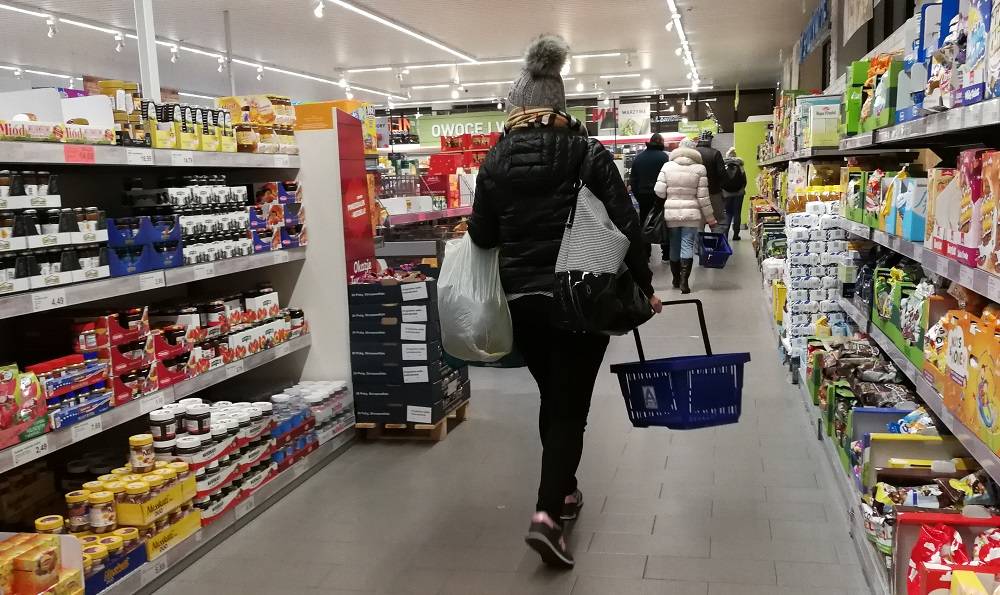Data from the monitoring of behaviors of over a million consumers suggests that in November of this year there was a decrease in traffic in stores compared to the same period last year. This was true for all types of stores. The overall decrease was nearly 11% year-over-year. In the case of food-industrial stores, it was over 15% year-over-year. The number of customers also slightly declined. However, the time spent in stores increased by just under 1%. Furthermore, the analysis shows not all types of stores attracted customers in equal measure. Food-industrial stores recorded a decrease of nearly 3%. Consumers spent an average of just over 10 hours in these shops, but nearly 4 hours in food-industrial stores.
Analysts from the tech company Proxi.cloud analyzed how traffic looked in November of last year in discount stores, hypermarkets, supermarkets, convenience stores, cash & carry stores, building markets, drugstores, non-food stores with trinkets, bookstores, non-food discount stores, clothing stores, RTV and household appliances outlets, furniture and interior stores, as well as sports, toy, and pet stores. The results were compared with data from the same period last year. Over 1 million consumer behaviors were monitored in nearly 48 thousand facilities. Anonymous data was collected through the so-called geofencing method. The report shows that all formats analyzed witnessed a decrease in traffic volume – overall by just under 11% year-over-year. It decreased by over 15% year-over-year in food-industrial outlets (i.e., discount stores, hypermarkets, supermarkets, convenience stores, and cash & carry chains).
The general decline in traffic is likely due to a combination of various factors. However, hypothetically it could be explained by the increasing popularity of online shopping. In terms of food chains, part of the decline may be explained by the growing popularity of catering services and food delivery. In my opinion, December’s analysis will show slightly higher traffic than in November, mainly due to Christmas preparations and two shopping Sundays in the preceding weeks – says Mateusz Nowak from Proxi.cloud.
On the other hand, Miłosz Sojka from the same company believes it is difficult to definitively predict how December’s store traffic will look. Many factors influence the decision to shop, from basic things like weather conditions, to the holiday gift list, to the way Christmas is celebrated (visiting family or staying at a hotel, hosting the holiday at home, etc.). The expert emphasizes that numerous promotions encourage shopping in the pre-holiday season.
In the case of purchases made in food-industrial stores, holiday shopping will undoubtedly boost the result – although savings may be visible here as well. I suspect that this year the Christmas gifts will be a bit more modest. This is due to the previously mentioned savings, inflation, but also changing consumer trends. I am referring to the purchasing decisions made by younger generations, who are more attracted to sustainable development and consumption trends, as well as limiting mass consumption – believes Prof. Katarzyna Sanak-Kosmowska from the Department of Marketing at the University of Economics in Krakow.
The declining store traffic in the period analyzed was accompanied by a decreasing number of customers. The overall year over year decline for all formats was just under 14%, and for food-industrial stores – less than 15% year-over-year. Prof. Katarzyna Sanak-Kosmowska from UE in Krakow links this to the ongoing competition from online stores.
In the case of some products, consumers prefer to shop online, which certainly reflects in the data from physical stores. As for food products, we see a clear preference for in-store shopping. Here, declines may be related to the aforementioned savings and not buying in bulk. Long-term trends are certainly also associated with the demographic changes occurring in Polish households. As a result of the pandemic, the food delivery segment has developed dynamically. In large cities, it is often an alternative to grocery shopping – explains Prof. Sanak-Kosmowska.
The expert adds that December is a time of holidays and family gatherings. Surely, just like in previous years, it will be a special month for consumers. However, they will be a bit more sensible in their decisions. A glimmer of hope to reverse the decline is the fact that in November the current consumer confidence indicator (BUWK) – according to GUS data – increased. This would mean that Polish consumers have come to terms with the price increase, and the mood in households is improving.
The collected data show that in food-industrial stores the dynamics depended on the category. In convenience store chains, declines were similar in terms of traffic volume and the number of buyers (respectively over 14% and over 14% year-over-year). In discount stores, the number of buyers decreased slightly more than the traffic (over 14% vs. close to 13% year-over-year). In hypermarkets it was the opposite. Traffic fell more than the number of customers (over 21% vs. over 19% year-over-year). The same was true for supermarkets (over 18% vs. close to 18% year-over-year). At this point, Prof. Sanak-Kosmowska points out that this might be due to the fact that shopping centers (including large stores) have become a place for leisure, especially in winter months.
Their interiors and offers are designed to make spending time as comfortable as possible. I am referring to children’s play zones, resting spots or coworking spaces. This results in maintaining traffic, which does not necessarily translate into completed purchases. In the case of supermarkets, an important phenomenon is also looking for promotions – therefore, checking offers and comparing them between stores. The scale of this phenomenon’s popularity is demonstrated by discussions on forums and groups on social media, where internet users share their findings and ‘hunted’ deals – adds the expert from the University of Economics in Krakow.
However, Miłosz Sojka from Proxi.cloud warns against drawing hasty conclusions about changes in the shopping specifics of customers of one format compared to others. In his opinion, these trends aren’t so defining to have a basis for that.
